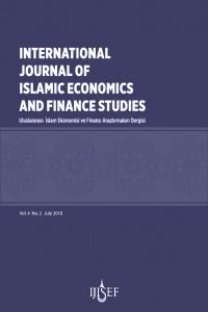The Effect of Institutions on Economic Growth in Muslim Countries
The Effect of Institutions on Economic Growth in Muslim Countries
For the last century, Muslim countries have been generally recalled by political and economic instabilities. They have been facing important problems such as poverty, internal turmoil, social disorders, lack of democracy, inadequate health services and low education level that obstruct their economic developments. These problems in general are addressed to the low level of governance and spoiled institutional structures of markets and political area. According to the good governance approach, efficient markets attract private investors which will drive economic development and growth. For a market to be efficient, various institutions must be established and markets must operate within that framework. This work examines the relationship between the institutions and economic growth in Muslim countries to address this problem. The problem statement is: Is there a significant relationship between the institutions and economic growth in Muslim countries? The D-8 Organization for Economic Cooperation Countries are used as a proxy of Muslim countries. World Bank World Governance Indicators are used as a proxy for the levels of institutions and UNDP Human Development Index is used to proxy human capital. Results show that there exists a significant relationship between the institutions and economic growth in Muslim countries.
Keywords:
Economic growth, Governance, Institutions, Economic development, D-8 countries Islamic economics,
___
- Acemoglu, D., & Robinson, J. (2010). The role of institutions in growth and development. In D. Brady & M. Spence (Eds.), Leadership and Growth (Vol. 10): World Bank Washington DC.
- Adams, S., & Mengistu, B. (2008). Privatization, governance and economic development in developing countries. Journal of Developing Societies, 24(4), 415-438.
- AlBassam, B. A. (2013). The relationship between governance and economic growth during times of crisis. European Journal of Sustainable Development, 2(2), 1-1.
- Coase, R. H. (1937). The Nature of the Firm. Economica, 4(16), 386-405.
- Çamlıbel, D. A. (2014). What are the determinants of economic growth in Muslim countries? Journal of Human Sciences, 11(1), 403-426.
- Faqeer, M., Rehmat, K., & Sajjad, H. (2020). Financial Development and Economic Growth: The Mediating Role of Quality of the institutions in Muslim Countries. Pakistan Social Sciences Review, 4(2), 245-256.
- Fayissa, B., & Nsiah, C. (2013). The impact of governance on economic growth in Africa. The Journal of Developing Areas, 91-108.
- Grindle, M. S. (2004). Good enough governance: poverty reduction and reform in developing countries. Governance, 17(4), 525-548.
- Guiso, L., Sapienza, P., & Zingales, L. (2003). People's opium? Religion and economic attitudes. Journal of monetary economics, 50(1), 225-282.
- Haini, H. (2020). Examining the relationship between finance, institutions and economic growth: evidence from the ASEAN economies. Economic Change and Restructuring, 53(4), 519-542.
- Hamilton, W. H. (1919). The Institutional Approach to Economic Theory. The American Economic Review, 9(1), 309-318.
- Hodgson, G. M. (2000). What is the essence of institutional economics? Journal of economic issues, 34(2), 317-329.
- Huang, C.-J., & Ho, Y.-H. (2017). Governance and economic growth in Asia. The North American Journal of Economics and Finance, 39, 260-272.
- Interactive Data Table: World Muslim Population by Country. (2017). Retrieved from https://www.pewresearch.org/religion/chart/interactive-data-table-world-muslim-population-by-country/
- Islam, M. R., & McGillivray, M. (2020). Wealth inequality, governance and economic growth. Economic Modelling, 88, 1-13.
- Kaufmann, D., Kraay, A., Lora, E., & Pritchett, L. (2002). Growth without governance [with comments]. Economia, 3(1), 169-229.
- Khan, M. (2007). Governance, economic growth and development since the 1960s.
- Klein, P. G. (1998). New institutional economics. Available at SSRN: https://ssrn.com/abstract=115811.
- Noland, M. (2003). Religion, culture, and economic performance. Available at SSRN 472484.
- Przeworski, A., Alvarez, R. M., Alvarez, M. E., Cheibub, J. A., Limongi, F., & Neto, F. P. L. (2000). Democracy and development: Political institutions and well-being in the world, 1950-1990: Cambridge University Press.
- Rigobon, R., & Rodrik, D. (2005). Rule of law, democracy, openness, and income: Estimating the interrelationships1. Economics of transition, 13(3), 533-564.
- Romer, P. M. (1994). The Origins of Endogenous Growth. Journal of Economic Perspectives, 8(1), 3-22.
- Rutherford, M. (2001). Institutional Economics: Then and Now. The Journal of Economic Perspectives, 15(3), 173-194.
- Siddiqui, D. A., & Ahmed, Q. M. (2013). The effect of institutions on economic growth: A global analysis based on GMM dynamic panel estimation. Structural Change and Economic Dynamics, 24, 18-33.
- Solow, R. M. (1956). A contribution to the theory of economic growth. The Quarterly Journal of Economics, 70(1), 65-94.
- Williamson, O. E. (1975). Markets and hierarchies: analysis and antitrust implications: a study in the economics of internal organization. University of Illinois at Urbana-Champaign's Academy for Entrepreneurial Leadership Historical Research Reference in Entrepreneurship.
- Zulkhibri, M., & Ghazal, R. (2017). The impacts of governance and institution on financial inclusion: Evidence from Muslim countries and developing economies. Journal of King Abdulaziz University: Islamic Economics, 30.
- ISSN: 2149-8393
- Başlangıç: 2015
- Yayıncı: Politik Ekonomik ve Sosyal Araştırmalar Merkezi
